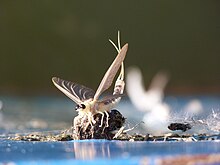Palingenia longicauda
- View a machine-translated version of the French article.
- Machine translation, like DeepL or Google Translate, is a useful starting point for translations, but translators must revise errors as necessary and confirm that the translation is accurate, rather than simply copy-pasting machine-translated text into the English Wikipedia.
- Consider adding a topic to this template: there are already 1,466 articles in the main category, and specifying
|topic=will aid in categorization. - Do not translate text that appears unreliable or low-quality. If possible, verify the text with references provided in the foreign-language article.
- You must provide copyright attribution in the edit summary accompanying your translation by providing an interlanguage link to the source of your translation. A model attribution edit summary is
Content in this edit is translated from the existing French Wikipedia article at [[:fr:Palingenia longicauda]]; see its history for attribution. - You may also add the template
{{Translated|fr|Palingenia longicauda}}to the talk page. - For more guidance, see Wikipedia:Translation.
| Palingenia longicauda | |
|---|---|
 | |
| Scientific classification | |
| Domain: | Eukaryota |
| Kingdom: | Animalia |
| Phylum: | Arthropoda |
| Class: | Insecta |
| Order: | Ephemeroptera |
| Family: | Palingeniidae |
| Genus: | Palingenia |
| Species: | P. longicauda |
| Binomial name | |
| Palingenia longicauda Olivier, 1791 | |
Palingenia longicauda is an aquatic insect in the order Ephemeroptera. It is known as the Tisa or Tisza mayfly after the European Tisza river where it is found and also as the long-tailed mayfly and giant mayfly since it is the largest mayfly species in Europe, measuring 12 cm (4.7 in) from head to tail.[1][2]
Unlike many other species of mayflies, adult P. longicauda never move away from water; they fly low and their cerci are frequently touching or sweeping the surface.[3] The slow-moving river and absence of surface-feeding fish help make this possible.[2] The presence of P. longicauda is an indicator of clean unpolluted water. Now extinct in many European countries, it can be found on the Tisza river (in Slovakia, Serbia and Hungary),[1] on the Prut and Bega (in Romania)[4] and on Ukrina (in Bosnia and Herzegovina).
Mating
Large numbers of P. longicauda larvae will usually hatch and mature during a week in mid June; this natural phenomenon is known as the 'blooming of the Tisza' or 'Tisza blooming' and is a tourist attraction.[1][2] (In Hungarian, the native name of the P. longicauda is tiszavirág, i.e. "Tisza blossom".) After hatching the adults only have a few hours to mate before they die. Consequently, groups of males will frantically try to mate with a female. Females will fly 1–3 km before laying their eggs on the river, which then sink to the bottom and hatch after about 45 days. The larvae develop in the mud for as long as three years before hatching.[5] Larvae live in tunnels in the mud at a density of 400 tunnels per square metre.[5]
References
- ^ a b c "Wild Serbia: The Tisa Mayfly (Palingenia longicauda". www.wild-serbia.com. Archived from the original on 2011-07-18.
- ^ a b c "Riverfly: Teifi Rivers Invertebrate Monitors: Europe's largest mayfly". www.riverfly.co.uk. Retrieved 5 February 2021.
- ^ Kriska, György; Balázs Bernáth; Gábor Horváth (February 2007). "Positive polarotaxis in a mayfly that never leaves the water surface: polarotactic water detection in Palingenia longicauda (Ephemeroptera)". Naturwissenschaften. 94 (2): 148. Bibcode:2007NW.....94..148K. doi:10.1007/s00114-006-0180-4. PMID 17136350. S2CID 24916697.
- ^ Bernerth, Haide; Tobias, Wolfgang; Stein, Stephanie; Turowski, Susanne (2002). "Section 4.2: Macrozoobenthos" (PDF). In Literáthy, Péter; Koller-Kreimel, Veronika; Liška, Igor (eds.). Joint Danube Survey: Technical report of the International Commission for the Protection of the Danube River. p. 42. Retrieved 2013-01-10.
- ^ a b William H Robinson (2005). Handbook of urban insects and arachnids. Cambridge University Press. ISBN 0-521-81253-4.
External links
- National Geographic: József L. Szentpéteri: With just hours to live, these swarming insects on Hungary's Tisza River have only one thing on their minds. (Archived on Wayback Machine)
- The Tisza River Project: http://www.tiszariver.com/ Archived 2002-02-04 at the Wayback Machine
- Tisza Mayfly, BioFresh Cabinet of Freshwater Curiosities.
- v
- t
- e











